Editor of this issue: Antanas Klimas
Copyright © 1985 LITUANUS Foundation, Inc.

|
LITUANUS
LITHUANIAN QUARTERLY JOURNAL OF ARTS AND SCIENCES
Volume 31, No.1 - Spring 1985
Editor of this issue: Antanas Klimas ISSN 0024-5089
Copyright © 1985 LITUANUS Foundation, Inc. |

|
THE WEAVINGS OF ANASTAZIJA TAMOŠAITIS
VICTORIA MATRANGA
Since the last article about Anastazija Tamošaitis in Lituanus (1974. Vol. 20. No. 4), this energetic artist has untiringly progressed further down her established creative paths. Now in her mid-70's, Mrs. Tamošaitis has amplified her definition of Lithuanian textile arts with frequent exhibits, lectures and writings. Her woven works continue to blend modernity with traditional folkways, complexity with simplicity. She also works in graphics and painting (oil and gouache) as self-contained studies and sketches for tapestries.
Two major events in Mrs. Tamošaitis' career occurred in 1977 and 1981. In 1977, a 23 minute 16 mm. color film, "Spirits of an Amber Past," was produced with the support of a federal grant from the Canadian government. Produced and directed by Ramūna McDonald (Vytautas Petrulis, filmmaker), the film followed Anastazija and her artist husband, Antanas Tamošaitis at their home and studio in Kingston, Ontario. The film described their work in weaving tapestries and Lithuanian national costumes.
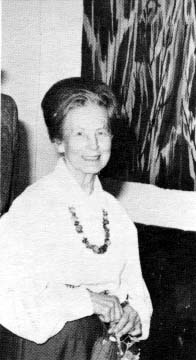
Anastazija Tamošaitis
The film was shown on BBC television in London, England twice: once in advance of the June, 1981 presentation of the gift of a Lithuanian wedding costume that Mrs. Tamošaitis had woven for the Royal Wedding of Diana and Prince Charles. The costume was offered as a gift from the Lithuanian citizens of England to the Princess much before the wedding, and when Diana accepted the offer of such a gift she selected the costume she would like from a book of traditional patterns. She chose the full complement of the Vilnius region, which Mrs. Tamošaitis wove according to her specifications. Local news coverage of the wedding remarked that the Princess had two wedding gownsthe one she actually wore and the Lithuanian costume.
In the ten years 1974 to 1984, Mrs. Tamošaitis mounted more than an average of one exhibit per year, in addition to her other activities. In the summer of 1974, she showed at the Manitoba Museum of Man and Nature, 1975 the Hamilton Multicultural Center, in Detroit in 1976,1980 saw a series of exhibits in South America: Bogota, Columbia and Caracas, Venezuela; in New York in 1981, then Philadelphia and Chicago in 1982. In 1983, her weavings appeared as part of a group exhibit of folk art at the Second Lithuanian World Festival in Chicago. A major one-person exhibit in 1984 of tapestries, lithographs and national costumes at the Sibley's Ward Gallery in Rochester, N.Y., was paired with a simultaneous exhibit in the same city of oils and watercolors at the St. George's Hall. 1985 will see more exhibits, and probably the appearance of a book, once again co-authored with her husband, on the weaving of sashes (juostos).
A fine example of her busy exhibition schedule was the impressive exhibit of tapestries displayed in October, 1982 at Chicago's Galerija, a gallery located in the near north side gallery district specializing in the work of Lithuanian artists. The exhibit attracted the notice of weavers and art critics with favorable reviews. Here, the gallery was transformed into a room exploding with color and light. As in medieval castles, the tapestries warmed the walls. Times past, legends, and the sea came to life in weavings that are the results of many hours of painstaking work.
This exhibit of 32 tapestries spanned work dating from 1947 to the present. The earliest weavings, in the traditional knotted pile method, described scenes from Lithuanian mythology in a clear visual style with muted greenish tones. Works from the last 15 years were notably different in color and style. Bright cool colors, blues and purples, are used in about half of the weavings. The royal blue hues she favors come from dyes imported from Germany on New Brunswick natural white yarns. The other weavings are done in earth tones, with unbleached yarns either purchased or of her own production, and with dyes of her own composition. She occupies herself in all phases of the weaver's art to bring the final tapestry to the gallery wall. She gathers berries, seeds and various plants to make the dyes, she spins the yarns, and builds the looms. She keeps tight control over each stage of the work this way. The recent works are visually startling for their flame-like, attenuated, vertical figures. It is occasionally difficult to discern or identify individual shapes within the composition because of the overriding verticality. This is sometimes due to the medium, stretching and constricting the figures once the tapestry is removed from the loom. It is also reminiscent of the paintings of El Greco, and she herself states that these tapestry weavings are fabric translations of her painting style.
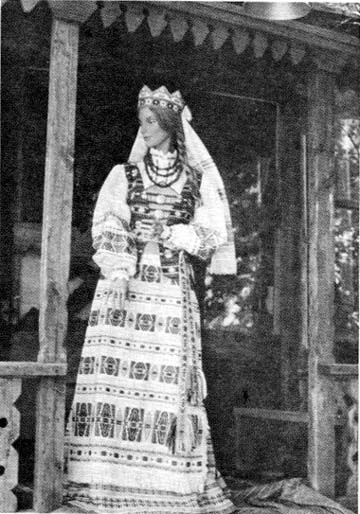
Lithuanian national costume of the Vilnius region. Designed and hand-woven by Anastazija Tamošaitis. Presented as a wedding gift to Lady Diana, Princess of Wales by the Lithuanians of England.
A master of many methods of weaving, Mrs. Tamošaitis displayed a sampling of perfect rib weave Gobelin, kilim, rya, basket weave and other techniques sometimes several techniques are used in the same work. Inventive treatments like braiding, alternating smooth and frayed edges, frame-within-the picture edging, and openwork slits are a demonstration of her versatility. She works predominantly in natural fiberswool, cotton and linen, and uses novelty yarns (mohair, metallic) for dramatic effect. Oriental carpets and European Renaissance tapestries frequently used gold and silver threads, and Mrs. Tamošaitis enjoys the historical, visual and textural contrasts in the contemporary works.
The representational works interpret subjects beloved in Lithuanian mythology: Jūratė and Kastytis, Eglė and Drebulė, The Serpent King's Family. Some also reveal her personal interpretation of her culture: August, Maiden's Farewell. One diptych, Day and Moonlight lovingly, eerily evokes earth spirits. Another diptych, Trillium Hills, recalls fields of fragrant blossoms, the trillium, Ontario's official flower. The abstract works repeat the rippling effect of water's waves and moods. Emotional intensity is expressed in vibrant colors and varying textures: nubby, flat, smooth, tight, and open.
This Lithuanian-born artist has lived in Kingston, Ontario, Canada since 1950. She began studying weaving in Kaunas in 1930, and continued her studies in Sweden and Austria. She has been teaching weaving nearly 40 years. She has received prizes in international exhibitions (Paris, 1937: Berlin, 1938; and New York, 1939) and has exhibited her work in the U.S., Canada and South America. Her tapestries are in the permanent collections of major museums and the Vatican. Her weavings perhaps add to the symbolism of religious rituals, so it is significant that monasteries commission her work. Her tapestry Trillium Hills is featured in F. P. Thomson's book Tapestry Mirror of History (Crown Publ., N.Y.).
The tradition of Lithuanian women weaving at home producing necessary household linens was the starting point of her art. She spends a good deal of her time weaving Lithuanian national costumes, and is the author of several books on handicrafts. Also a historian, she collaborated with her husband Antanas Tamošaitis, in the preparation of the book Lithuanian National Costume, (published in English by the Lithuanian Folk Art Institute, Toronto, 1979). The book is a lavishly illustrated examination of rural dress from a scholarly, artistic and technological viewpoint. She continues to teach and conduct workshops and seminars on the techniques of tapestry weaving; and particularly enjoys working with young people. By now, after so many years of experience, her deep love of the medium, understanding of the techniques, and involvement with the themes express themselves harmoniously. She lives in the woods on the banks of the St. Lawrence River and grew up near the Baltic Sea. The cool blue colors of the water, the shimmering, rippling character of the waves, and sea motifs dominate her work. She is calm, reflective and atone with nature. When describing the frame of a loom she is currently working on, she says "This is a nice-sized loom and it's portable. You can take it outside and work while sitting on the veranda or under a tree." How apt, and how revealing of her spirit. She says she most enjoys working on a tapestry loom 6 feet by 8 feet, and this size takes about 3 months of work. She recently acquired a 10 foot loom and will begin doing larger tapestries. Her youthful enthusiasm and wide-ranging human interests characterize her excited references to future workit's what is yet to be done that energizes her.
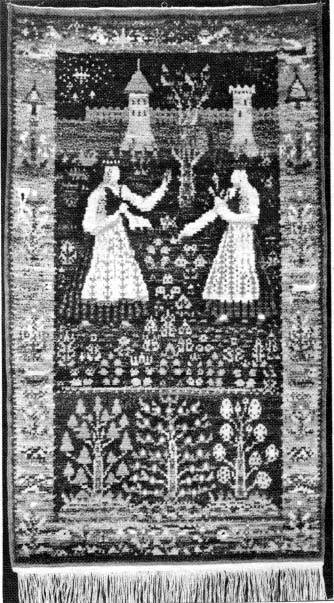
Lithuanian folklore "Enchanted Castle". Knotted pile, wool on linen. 1947, 33" x 64".
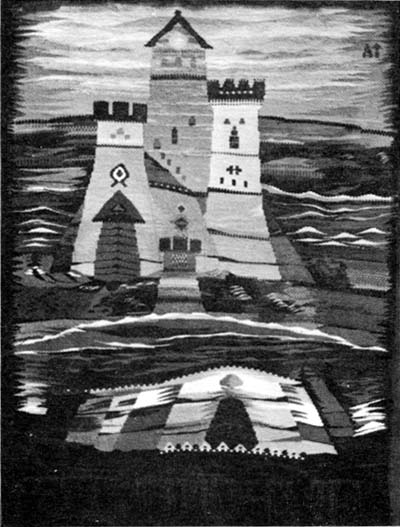
"Palace of the Sun". Tapestry, wool on cotton. 1980, 52.5" x 42.5".
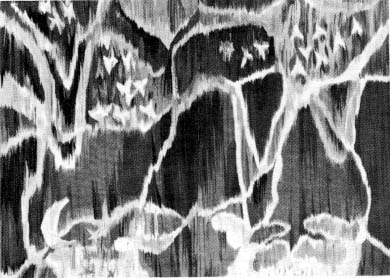
"Trillium Hills". Tapestry, wool on linen. 1970, 6' x 8'.
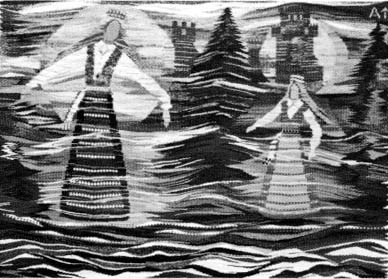
Lithuanian legend "Eglė and Drebulė". Tapestry, wool on cotton. 1979, 67" x 78".
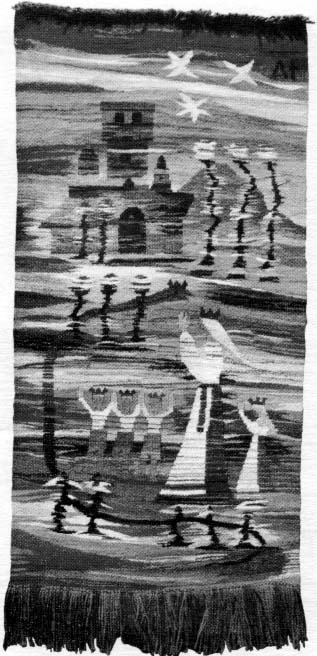
Lithuanian legend "Eglė, Queen of the Serpents". Tapestry, wool on cotton. 1970, 64 x 121 cm.
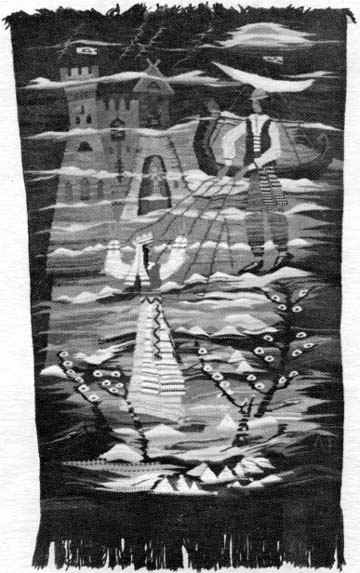
Lithuanian legend "Jūratė and Kastytis". Tapestry, wool on linen. 1982, 35" x 60".
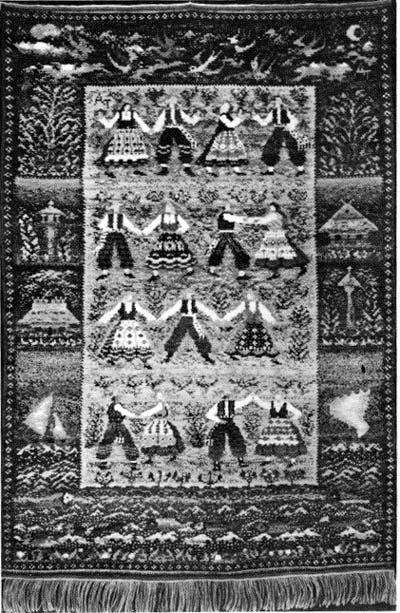
Anastazija Tamošaitis. "Folk Dance". Knotted pile, wool on linen. 1946, 49" x 73".